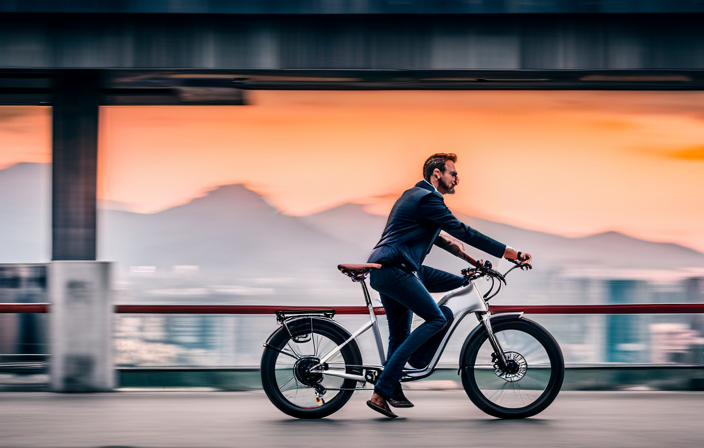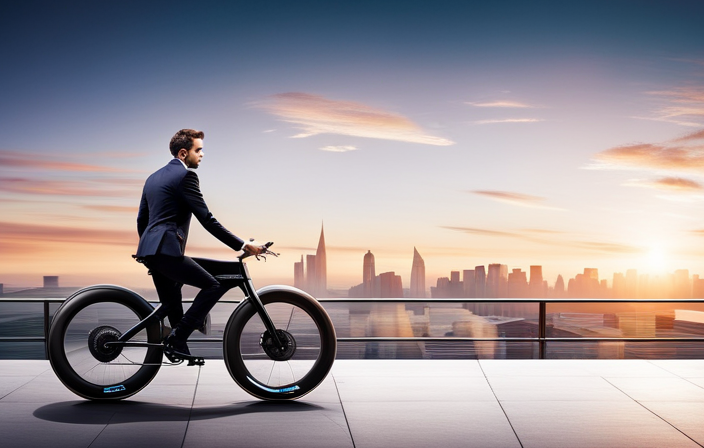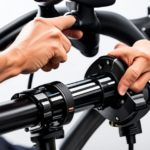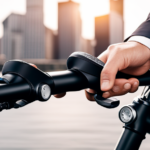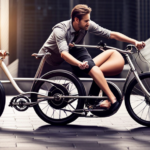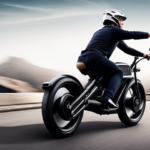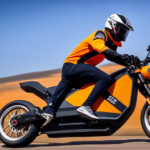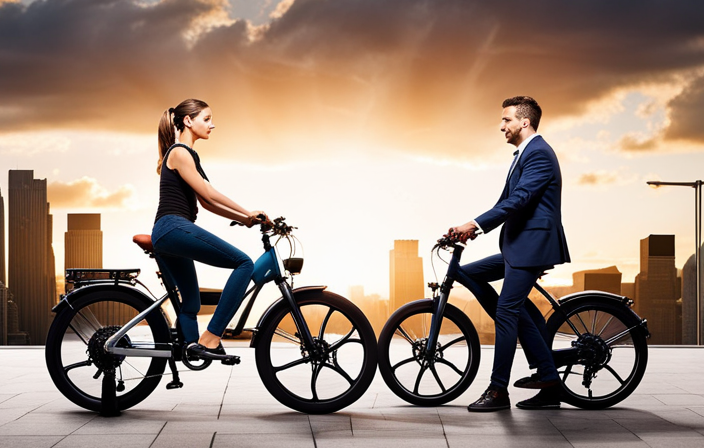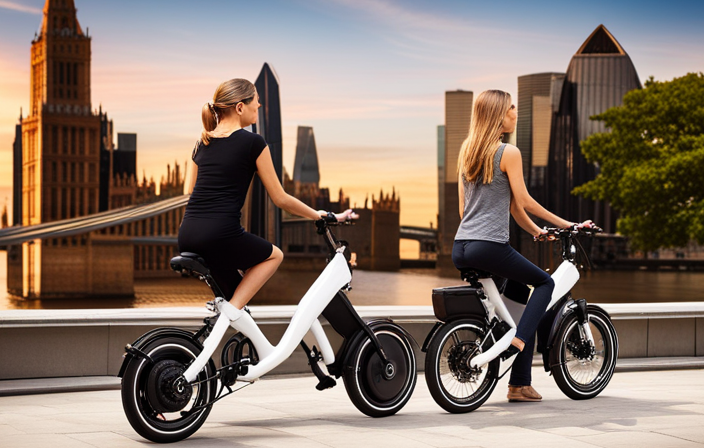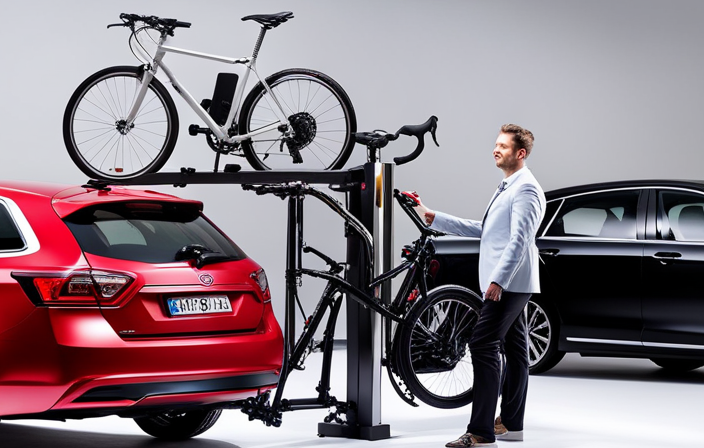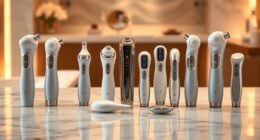I’m going to show you how to create your very own electric bike throttle.
Picture this: you’re cruising down the road, effortlessly gliding on your custom-made throttle. With just a twist of your wrist, you have complete control over your bike’s power.
It’s a technical process, but I’ll guide you step by step. Gather the materials, understand the basics, and choose the type of throttle you want.
Get ready to embark on this detailed journey, and soon you’ll be enjoying the ride of a lifetime.
Key Takeaways
- Properly position and align the throttle on the handlebars for easy reach and ergonomic grip.
- Test and troubleshoot throttle issues to ensure smooth speed changes and address any unresponsiveness or inconsistency in motor response.
- Use appropriate tools to securely tighten the throttle and manage throttle cables to prevent obstruction.
- Customize the throttle to suit personal riding style and preferences, while ensuring secure attachment for rider safety and control.
Gather the Necessary Materials and Tools
To begin making an electric bike throttle, you’ll need to gather all the necessary materials and tools.
For the materials, you will require a potentiometer, which is a variable resistor that allows you to control the speed of your electric bike. Additionally, you will need a throttle handle, which is the part you will grip to control the throttle. Other materials include wires, connectors, and heat shrink tubing to ensure proper connections and insulation.
As for the tools, you will need a soldering iron to join the wires and connectors, wire strippers to remove the insulation from the wires, and a heat gun to shrink the tubing.
Having all these materials and tools ready will ensure a smooth process as you move on to understand the basics of electric bike throttles, such as the wiring and installation.
Understand the Basics of Electric Bike Throttles
If you want to understand the basics of using an electric bike throttle, you’ll need to familiarize yourself with its functions and how it operates. Electric bike throttles allow riders to control the speed and power of their bikes with ease. Here are some key points to keep in mind:
-
Pros of electric bike throttles:
-
Easy acceleration and deceleration.
-
Convenient for riders with limited physical abilities.
-
Provides a smooth and effortless riding experience.
-
Allows for precise control over speed.
-
Enhances the overall fun factor of riding an electric bike.
-
Cons of electric bike throttles:
-
Can consume more battery power compared to pedal-assist systems.
-
May not be legal in certain areas or on certain trails.
-
Requires constant attention to throttle control for safety.
-
Can be less efficient for longer rides.
-
Less exercise compared to pedal-assist systems.
Common issues with electric bike throttles:
- Inconsistent throttle response.
- Malfunctioning or sticking throttle.
- Difficulty in finding the right balance of speed and power.
- Limited range due to excessive throttle usage.
- Throttle sensitivity issues.
Understanding the pros, cons, and common issues with electric bike throttles is crucial for a smooth and enjoyable riding experience. Now let’s move on to choosing the type of throttle you want to create, and explore the various options available.
Choose the Type of Throttle You Want to Create
Before deciding on the type of throttle you’d like to create, it’s important to consider your specific needs and preferences. There are different types of electric bike throttles available, each with its own pros and cons.
The most common types include twist grip, thumb throttle, and thumb lever throttle. The twist grip throttle is similar to a motorcycle throttle, where you twist the grip to control the speed. It offers precise control and is easy to use.
The thumb throttle is a popular choice as it allows for one-handed operation and is comfortable to use. The thumb lever throttle is a combination of a thumb throttle and a brake lever, which can be convenient for some riders.
Now that you have an idea of the different types of throttles available, let’s move on to the next step of the process: measuring and cutting the handlebar grip.
Measure and Cut the Handlebar Grip
Next, you’ll need to measure and cut the handlebar grip to ensure a proper fit. This step is crucial to ensure that the throttle will be comfortable and easy to use. Here’s how to do it:
-
Select a suitable handlebar grip: Look for a grip that is the right size and shape for your hand. It should provide a good grip and be comfortable to hold for long periods of time.
-
Measure the handlebar: Use a measuring tape to determine the length of your handlebar. Make sure to measure from end to end, including any curves or bends.
-
Cut the grip to size: Once you have the measurements, use a sharp utility knife to cut the grip to the appropriate length. Take your time and make clean, precise cuts.
Prepare the Control Box
To prepare the control box, you’ll need to gather the necessary tools and materials. Here is a table of what you’ll need:
| Tools | Materials |
|---|---|
| Screwdriver | Control box |
| Wire cutters | Wires |
| Soldering iron | Heat shrink tubing |
| Multimeter | Electrical tape |
Now that you have everything ready, let’s move on to troubleshooting common issues with electric bike throttles. One common issue is a faulty throttle response. This can be caused by loose connections or worn-out components. To troubleshoot, check all the connections and make sure they are secure. If that doesn’t solve the issue, use a multimeter to test the throttle’s resistance. Another way to customize the appearance of your electric bike throttle is by adding a custom grip or cover. This can be done using various materials like rubber, leather, or even 3D-printed parts. Once you have prepared the control box, it’s time to connect the wires and components.
Transition into the subsequent section about ‘connect the wires and components’: "Now that the control box is ready, let’s move on to connecting the wires and components."
Connect the Wires and Components
Now you can start connecting the wires and components in the control box. This is a crucial step in the process of assembling your electric bike throttle.
To ensure proper functionality, follow these steps:
-
Begin by identifying the wires and components according to the manufacturer’s instructions.
-
Carefully strip the insulation off the wire ends, ensuring that you have a clean and exposed copper surface.
-
Connect the wires by twisting them together and securing them with electrical tape or soldering them for a more secure connection.
-
Assemble the components according to the diagram provided, making sure to align them correctly and secure them in place.
-
Double-check all wire connections and component assemblies to ensure they are secure and properly aligned.
By following these steps, you will have successfully connected the wires and assembled the components in your control box.
Now, it’s time to move on to the next phase and test the functionality of the throttle without delay.
Test the Functionality of the Throttle
To ensure everything is working properly, you should give the throttle a test run before proceeding.
Testing different throttle designs is crucial to determine which one suits your needs best.
Start by connecting the throttle to the controller and ensuring all the wires are properly connected. Once connected, turn on the power and gradually twist the throttle.
Observe if the motor responds accordingly, smoothly increasing or decreasing in speed.
If there are any issues, such as the motor not responding or the throttle not providing a consistent output, you may need to troubleshoot common throttle issues. This could involve checking the connections, adjusting the throttle tension, or replacing faulty components.
Once the throttle is functioning correctly, you can proceed to secure it to the handlebars, providing a comfortable and stable grip for the rider without compromising control.
Secure the Throttle to the Handlebars
Once you’ve ensured the throttle is functioning correctly, it’s time to secure it to the handlebars for a comfortable and stable grip. The importance of throttle security for rider safety cannot be overstated. A loose or unstable throttle can lead to accidents and loss of control.
However, securing the throttle to the handlebars can present some common challenges. Here are some tips to help you overcome them:
-
Positioning: Properly position the throttle on the handlebars, ensuring it is within easy reach of your thumb and does not interfere with other controls.
-
Alignment: Align the throttle with the handlebars, making sure it is parallel to the ground for a natural and ergonomic grip.
-
Tightening: Use the appropriate tools to securely tighten the throttle to the handlebars, ensuring it doesn’t move or rotate during use.
-
Cable Management: Properly manage the throttle cables, ensuring they are not tangled or obstructing other components.
By following these steps, you can ensure the throttle is securely attached, providing a safe and reliable riding experience.
Now, let’s move on to fine-tune and adjust the throttle settings to optimize your ride.
Fine-tune and Adjust the Throttle Settings
After securing the throttle to the handlebars, you can fine-tune and adjust its settings for a more customized riding experience.
To begin, locate the throttle sensitivity adjustment screw, typically found near the throttle assembly.
Turning the screw clockwise will increase the sensitivity, allowing for quicker acceleration, while turning it counterclockwise will decrease sensitivity, providing a smoother and more gradual response.
It’s important to find the right balance for your preferences and riding style.
If you encounter any issues with the throttle, such as it not responding or being too sensitive, troubleshooting may be necessary.
Check the wiring connections, ensure proper voltage supply, and inspect for any physical damage or debris.
Enjoy Your Custom-Made Electric Bike Throttle!
You can truly appreciate the unique riding experience provided by your customized electric bike throttle. With a wide range of customization options available, you can tailor your throttle to perfectly suit your riding style and preferences.
Whether you prefer a more responsive throttle or a smoother acceleration, the customization options allow you to fine-tune the throttle settings to your liking.
Troubleshooting tips are also available to ensure that your custom-made throttle operates smoothly and efficiently. If you encounter any issues, such as a lag in response or inconsistent acceleration, you can refer to the troubleshooting guide for step-by-step instructions to resolve the problem.
Frequently Asked Questions
How much time does it take to make an electric bike throttle?
I can’t provide a specific time frame for making an electric bike throttle without the context of the manufacturing process. However, with good time management and troubleshooting techniques, the process can be completed efficiently and effectively.
Can I use any type of handlebar grip for the throttle?
Yes, any handlebar grip can be used for the throttle as long as it fits securely. However, it’s important to consider throttle positioning and ergonomics to ensure comfortable and safe operation of the electric bike.
What tools are required to connect the wires and components?
To connect the wires and components, you will need a soldering iron and wire strippers. The soldering iron is used to melt solder and join the wires together, while wire strippers are used to remove the insulation from the wires for proper connection.
How do I know if I have connected the wires correctly?
To troubleshoot wiring connection issues, first ensure that all wires are securely connected and properly insulated. Then, use a multimeter to test the continuity of the connections. To test the throttle functionality, connect it to the controller and check if it responds correctly to input.
Is it possible to adjust the throttle sensitivity after it is installed?
I wouldn’t recommend adjusting the throttle sensitivity on an electric bike after installation. It can lead to potential dangers, such as sudden acceleration or loss of control. However, having adjustable throttle sensitivity can provide benefits like improved comfort and control while riding.
Conclusion
After gathering the necessary materials and tools and understanding the basics of electric bike throttles, I chose the type of throttle and measured and cut the handlebar grip.
Then, I prepared the control box and tested the functionality of the throttle. Once it was working perfectly, I securely attached it to the handlebars and fine-tuned the throttle settings.
Now, I can enjoy riding my electric bike with a custom-made throttle! It’s amazing to think that by making this simple modification, I’ve increased my control and efficiency while riding.
